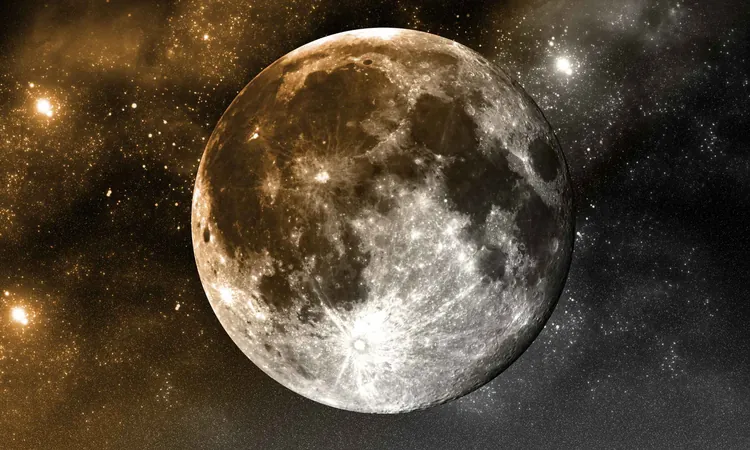
NASA Sounds the Alarm: Human Activities Could Poison the Moon's Atmosphere!
2024-12-28
Author: Yan
As humanity prepares to return to the Moon by the end of this decade, experts are issuing a stark warning.
Our plans for lunar exploration and exploitation could inadvertently create perilous, short-lived toxic atmospheres composed of moon dust, threatening both missions and the health of astronauts.
The Moon currently possesses a weak, almost nonexistent atmosphere known as an exosphere. However, increased human activity—from astronaut excursions to mining operations and rocket launches—promises to disturb this delicate environment. Notably, large clouds of regolith, or lunar dust, could be stirred up, introducing unforeseen dangers.
Rosemary Killen, a planetary scientist at NASA's Goddard Space Flight Center, has voiced her unease regarding the tiny, hazardous particles that could rise into the air due to human interventions. "One major concern is that the dust stirred up by exploratory activities will be laden with harmful substances," she remarked.
Understanding Moon Dust: The Hidden Dangers
Moon dust, or regolith, is comprised of fine particles that have accumulated over billions of years from asteroid impacts and solar winds. These particles pose significant health risks when disturbed—rocket thrusts and rovers can kick up the dust, leading to reduced visibility and potential respiratory issues. Moreover, moon dust can damage sensitive equipment, as its static properties may disrupt electronic instruments.
Human activities will also add volatile compounds to this fragile environment. Exhaled vapors and leakages from life support systems provide gas that, while short-lived, can spread vast distances and potentially interfere with critical lunar research. This added contamination raises alarm bells for scientists poised to analyze pristine ice in ancient, shadowed craters on the Moon—ice that could hold the secrets of our solar system’s history.
The Quest for Ancient Knowledge at Risk
Scientists are eager to explore these untouched areas to uncover water's history on the Moon and its role in Earth's evolution. However, the introduction of even minimal amounts of gas or water vapor could skew the findings, masking potential chemical evidence critical to understanding lunar and terrestrial origins.
NASA’s Artemis missions aim to transport astronauts and cargo to the lunar surface, yet large spacecraft, like the planned Starship variants, could create massive dust clouds upon landing. While mission planners are working to minimize these disturbances by selecting appropriate landing sites, experts caution that even a short burst of rocket thrust could forcibly eject moon dust across significant expanses, compromising untouched regions.
The Perils of Moon Dust: An Urgent Call for Caution
The dangers of moon dust extend beyond its irritating properties. Exposure could result in serious lung damage and significant wear on spacesuits and machinery, ultimately increasing risks for long durations on the Moon. Dust particles can easily be tracked back inside habitats, posing health risks for astronauts living and working in closed environments.
To protect critical scientific resources, regions of the Moon that have been preserved for billions of years must be treated with utmost care. Certain darker craters, believed to contain ancient ice, may yield invaluable insights into the history of water on our planet and its satellite. Scientists are advocating for stricter regulations surrounding lunar operations to limit contamination and preserve these scientifically significant areas.
Navigating the Balance Between Exploration and Environmental Preservation
While humanity's return to the Moon heralds thrilling opportunities for discovery, experts emphasize the need for responsibility and restraint. Thoughtful mission designs, careful landing techniques, and regulated resource extraction could help maintain the Moon's pristine condition while still allowing for exploration.
NASA is committed to gathering critical data to distinguish what is a natural component of the lunar environment from human-derived materials. Understanding the implications of moon dust and its impact on exploration will be essential for future missions.
As we gear up for an exciting new chapter in lunar exploration, we must stay vigilant about the effects of our presence on the Moon. By fostering collaboration among space agencies, researchers, and private enterprises, we can ensure that our lunar endeavors lead to incredible discoveries while safeguarding this celestial body for generations to come.


 Brasil (PT)
Brasil (PT)
 Canada (EN)
Canada (EN)
 Chile (ES)
Chile (ES)
 Česko (CS)
Česko (CS)
 대한민국 (KO)
대한민국 (KO)
 España (ES)
España (ES)
 France (FR)
France (FR)
 Hong Kong (EN)
Hong Kong (EN)
 Italia (IT)
Italia (IT)
 日本 (JA)
日本 (JA)
 Magyarország (HU)
Magyarország (HU)
 Norge (NO)
Norge (NO)
 Polska (PL)
Polska (PL)
 Schweiz (DE)
Schweiz (DE)
 Singapore (EN)
Singapore (EN)
 Sverige (SV)
Sverige (SV)
 Suomi (FI)
Suomi (FI)
 Türkiye (TR)
Türkiye (TR)
 الإمارات العربية المتحدة (AR)
الإمارات العربية المتحدة (AR)